Slack Analytics by Flowtrace
Use our Slack analytics to understand your team collaboration. We benchmark your usage to industry standards and best practices to create...
Free Slack best practice guide: Use this guide to learn how to use Slack analytics, benefits of Slack best practice, and get Slack policy template.
We have all seen it many times how information gets lost between Slack, email, and other collaboration tools we use daily basis. It's frustrating, wasteful, and in the worst case, causes issues to our clients. This is highlighted further when studies reveal that 89% of people believe effective collaboration is extremely important, and meanwhile 8 out of 10 people rate their own business' communication as an average, or poor. (Communication Statistics by Project.co)
We have collated Slack best practices across our clients and wanted to share these with you and your team. By reading this article you will gain more knowledge on why Slack best practices are important, how to assess your current Slack communication using Slack analytics, and how to improve cross-functional collaboration.
If you are here for the free Slack best practice guide, look no more, you can download it from here:
If you are here to learn about the most common Slack mistakes, and problematic inter-team communication patterns, please read on. By doing so we will help you assess your current Slack communication with Slack's built in analytics, and how to get your team behind the need to improve your current Slack communication. You can also read why we think the built-in Slack statistics is not enough.
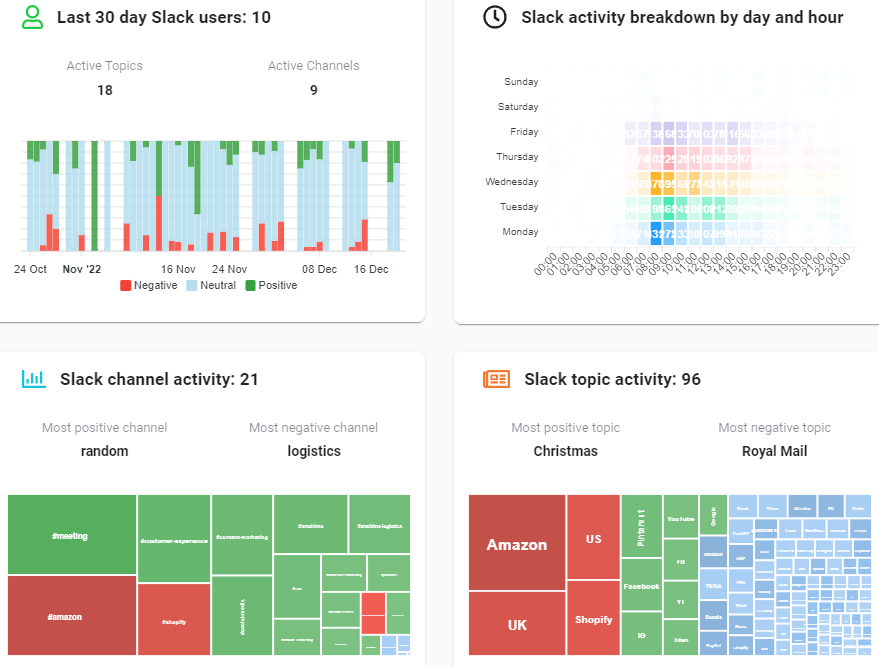
You might have not considered what impact the information sharing habits in Slack means to your business in the early years of your growth, but you should understand the impact these have further down the line.
We are highlighting 3 core benefits you can achieve by implementing these basic Slack best practices not only to your working style, but sharing the knowledge with your team using our Free Slack Employee Policy template. These benefits are core use-cases to all of our clients. (Flowtrace use cases)
On top of the 3 benefits we outline below, by using Slack best practices and effective cross-functional collaboration also increases employee engagement, accelerates the value delivery, aligns your products with your business strategy and allows you to adapt to change faster. (4 benefits of cross-functional agile teams)
We have all been there where the content, or document we saw couple of weeks ago just cannot be found anymore. Was it in Slack? No, maybe it was an email? This is an example from the weeds, but the same play is happening at a strategic level.
Information is key to driving the future decision culture. You should not approach information sharing as only a better way to improve your productivity, but gain strategic advantage in the marketplace you are operating in. (Why data culture matters by Deloitte)
Finding and gathering information is something that knowledge workers spend 19% of their workweeks (International Data Corporation and McKinsey Global Institute). This does not include the wastage of working on a project, or feature, which is based on outdated information just because your information sharing practices didn't follow the Slack best practices.
All these information bottlenecks and organizational silos are a costly way to frustrate your employees and clients. You should definitely work on reducing the amount of time people waste searching important information.
The benefits to the bottom line are obvious, and the reasons of poor information sharing practices are many. There is a tremendous amount of companies who have struggled with remote information sharing and we can comfortably tell you its not about returning back to the office which solves these issues.
Leading an organization where every team or function tries to work towards their own goal is time consuming. Many times your teams see the company goals from their perspective, which just isn't the same as the other teams. Most of the time the misalignment between teams is due to information silos, perceived, or actual.
Teams need access to information no matter who owns that information. Many of tools you currently use lack the support for effective information sharing due to per-seat pricing models, and limited access, meanwhile some other sources of friction are just plainly bad sharing habits.
Consider a project plan example where a couple of people from a team worked together on the plan and shared their draft version in Slack. Over time the documents end up being named like this:

Now, this is confusing during the project initiation and mistakes of wrong version reviews were made, but at least the people who put this together had the same context as they worked on it at the same time.
When the project eventually got the go-ahead and is in motion, other teams across your company get involved. They still won't have access to the documents stored in someone's computer but they rely on the document they saw in Slack called "Project Final Final.doc".
You can imagine what kind of costs, and problems this can create when communicating with clients, vendors, or just teams across the organisation if their source of information is based on different documents, which is now 5 versions behind the actual approved project plan.
All this could have been avoided if your team would have followed the Slack best practice of sharing a link to the document, instead of the given file version.
This would have saved time during the creation of the project plan, but more so, saved a lot of misalignment between teams later on when everyone sees there is only a one document, which is a link to the latest version by default.
The above example happens in companies every day, with documents, or with information from other SaaS tools, and causes a lot of waste, misalignment, and client frustration.
In the early days of company's growth, cross-functional collaboration is not an issue. The way how work gets passed between people and teams happen organically. Individuals at an early stage learn how to work together innately and agree implicit rules and ways of working together. We all bring our own experiences and best practices with us and we adapt easily to the context when handovers and cross-functional collaboration is between couple of people only.
When we scale and formalize the organization structure the implicit rules and habits start to take a toll. There are so many people we need to collaborate with, each with their own preferences.
Learning individual styles of how Mario from engineering wants to work, and how Matt from marketing prefers working is not efficient or feasible when we have only couple of touch points across the year.
We need something more systematic, and something that we can fallback as a collaboration culture blueprint.
Communicating and agreeing how to do handovers, and how to set the expectations during the handover becomes business critical.

Often times we see the first attempt of consolidating the inter-team collaboration starts with dedicated members of the team who is responsible for receiving, and passing on work to and from other teams.
This can be considered as a band aid and it does improve cross-function collaboration in the long term. Eventually, this only leads to a point where the said individual from a team becomes an information broker, and in the worst case, a bottleneck for passing information across the teams.
We have seen success at our client teams from the initiative of defining the team handovers as part of company culture.
These are explicit rules of engagement for the most common tasks which are being handed over.
When people across your team have knowledge of the base template, individuals find it easier to collaborate and work around the unique needs of any given handover.
The explicit cross-functional collaboration baseline speeds up the information sharing, and defines the expectations what should happen if something deviates from the norm. The golden rule of 80/20 applies here when 80% of the inter-team work gets done with 20% of the effort, leaving your people in charge of dealing with the 20% of special cases as one offs.
We have spoken about the impact of Slack best practices in your teams daily work and you might be convinced your team needs support. How do you know where to start and how good, or bad the situation is at your team?
By following the next steps you will know more about your Slack statistics, and what these reveal about the way you work. You can also look at how you compare to the great, average, and not so great Slack best practices.
The easiest way to see the state of your Slack best practices in action comes from a collective number about your ongoing conversations in your Slack workspace.
You can see your team's conversation style by using 3 metrics which are a ratio between public conversations, private conversations, and direct messages. You can view your current Slack statistics from:
You can see your workspace name from the Slack menu, here you can navigate directly to Slack analytics using Slack UI shortcut like this:
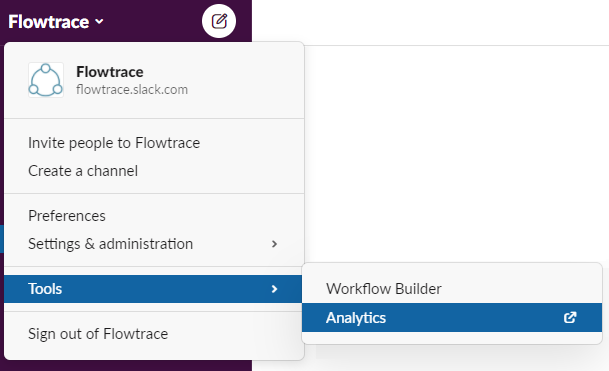
The first thing you see is your active users, and where people post and read their messages. You should be looking for the ratio between conversations taking place in the types of channels. I have highlighted the numbers of interest below:
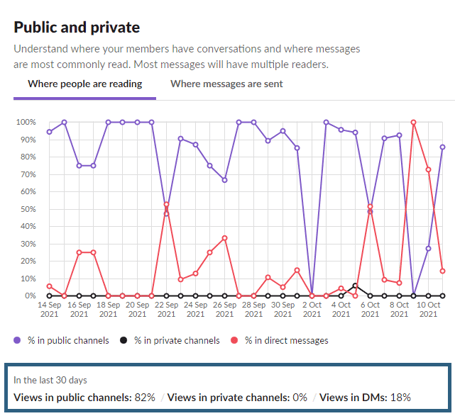
Take a note of the percentages of public channel views, and sent messages. This is the number you should pay attention going forward.
For the most effective cross-functional collaboration you need transparent and well flowing information and communication. You want to avoid creating information silos intentionally, or accidentally.
Private Slack channels is by its definition an information silo. People cannot search its content, or even know about important content if they don't have access to the slack private channel which could be instrumental to their work deliverable.
We are perplexed about the Slack habits and practices many of our to-be clients had prior to engaging with us. We have seen Slack setups where only one tenth of the conversations take place in public channels.
Obviously many of our client engagements have started with realization that their hunch of systematic issues of Slack usage or information sharing in Slack have been confirmed by this easy step.
With our help we have then devised plans how to develop internal communication and collaboration culture towards open and transparent information sharing.
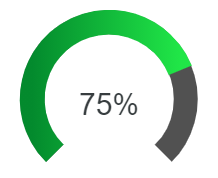 We need to start the benchmark against the Slack and the company itself. Reporting shows that approximately 70% of conversations take place in public channels and the company barely uses email for internal communication and collaboration. This can be considered a world class, and awesome level of team communication culture.
We need to start the benchmark against the Slack and the company itself. Reporting shows that approximately 70% of conversations take place in public channels and the company barely uses email for internal communication and collaboration. This can be considered a world class, and awesome level of team communication culture.
We have created a simple dial for you to benchmark yourself and see what, if any, action you should take to improve collaboration among your teams.
We can use Slack's own 70% of public conversations as a guideline for well collaboration companies. According to our experiences, anything below 50% can cause unintended, and accidental information silos which cause less productive company, misaligned teams, and wasted efforts because of outdated, missing, or wrong information.
Don't worry, event if you fall below the world class benchmark, these numbers give you a strong basis to start improving, and measuring the impact you are making as a leader.
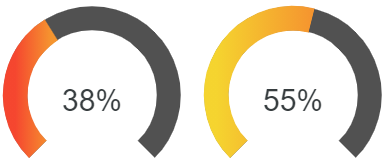
I have personally seen a company where only 5% of conversation took place in public channels.
This company had a toxic culture, where hiding communication was a survival instinct to many employees.
Over the course of coming months and years we managed to adopt a (more) transparent culture where sharing news or information was not considered as a reason to end up in trouble.
We have covered the benefits of Slack best practices, cross-functional collaboration, and transparent information sharing. We have also looked at how to use one metric to indicate how you gauge your current communication and collaboration culture using tools like Slack's built-in analytics.
You are left with a question what now? Great, we have compiled a list of topics you can action today, which also support continual improvement and building internal communication resilience.
We have compiled an easy to follow Slack best practice guide for you. This guide covers the basics about channel conventions and how to use Slack shortcuts, but it also points quick wins you can do right now.

It's one thing to learn something yourself, but its even better when you can share some of your knowledge with your whole team.
Our Slack guide has download links to 'Free Slack employee policy' template which you can use to create your own personalized document for all your employees. It's really handy especially for new employees when they join your team and need a place to learn the ropes of how your team uses Slack.
If you are interested in more advanced ways of improving your communication and collaboration culture, you definitely have landed in the right place.
Here's an example how one of our clients improved Slack thread usage with our recommendation and "how to" article from ~10% to 45% in just 4 weeks. This resulted in significant reduction of distracting notifications, and improved communication between their teams:
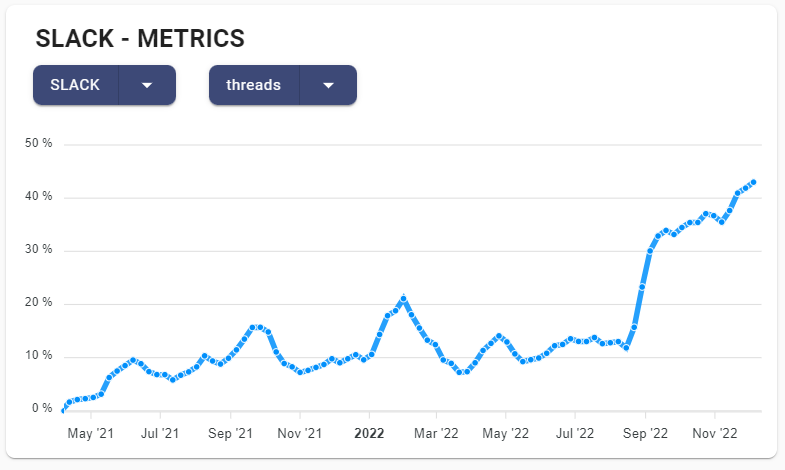
We exist to make every company more productive, free of information silos and place where employees feel engaged. We offer free access to our platform limited to 5 Slack channels for all companies and you can get started right now. Read about the benefits our recommendations from our Slack analytics and recommendations article.
You will get access to insights about your inter-team collaboration in minutes, and have access to our library of free resources spanning topics of internal meeting guides, cross-function collaboration, how to gain more focus-time and many many more.
For companies requiring more in depth analytics we offer advanced plans on top of the 5 Slack channels including insights into your meeting culture, cross-functional relationships and employee engagement metrics.
These metrics can be complimented with voice of your employees via our weekly pulse surveys which they will love to answer.
Use our Slack analytics to understand your team collaboration. We benchmark your usage to industry standards and best practices to create...
Flowtrace's Slack Analytics Dashboard helps teams improve communication and collaboration with best practice metrics and actionable recommendations.
Solution-based guide for tech startups to streamline meetings, improve Slack usage and measure productivity